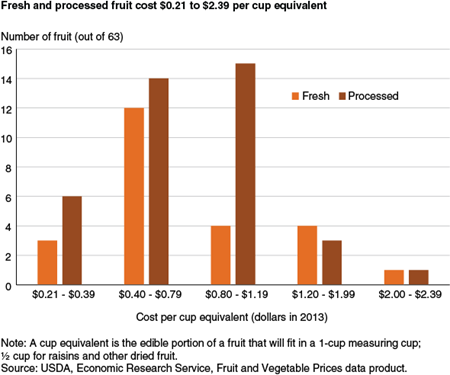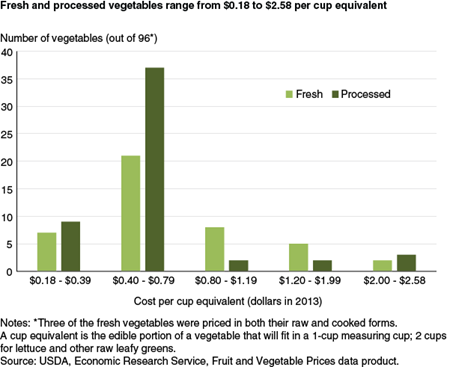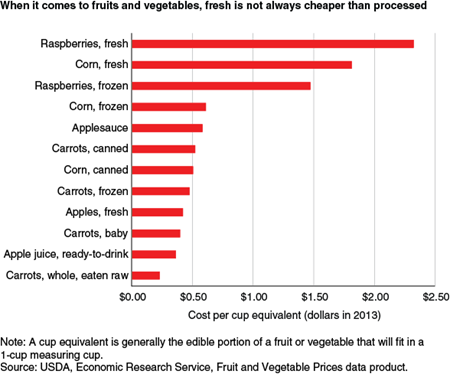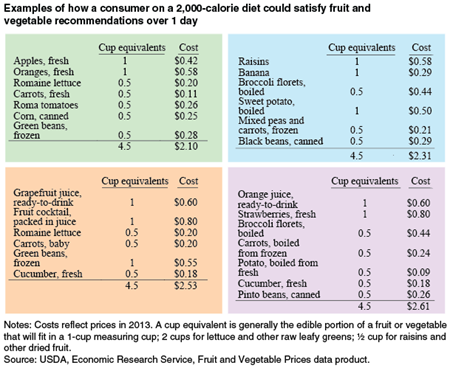Fruit and Vegetable Recommendations Can Be Met for $2.10 to $2.60 per Day
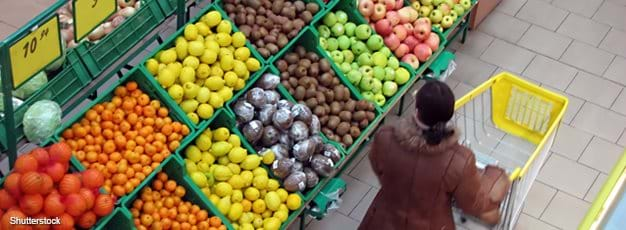
Increasing Americans’ fruit and vegetable consumption has been a long-standing goal of nutrition advocates and health-oriented government agencies. The 2015-2020 Dietary Guidelines for Americans echoes advice from the 2010 and 2005 editions of the Dietary Guidelines that persons needing 2,000 calories per day include 2 cups of fruit and 2.5 cups of vegetables in their daily diets. According to ERS research, however, the average American adult consumes only 1.1 cups of fruit and 1.6 cups of vegetables per day.
Individuals choose foods based on taste, convenience, cost, and other factors. Cost, in particular, has been cited as a possible barrier to increasing fruit and vegetable consumption. Lower income households have reported in surveys that high prices for these foods prevent them from eating more. A recent ERS analysis of average 2013 grocery store prices reveals that 2 cups of fruit and 2.5 cups of vegetables can be obtained for $2.10 to $2.60.
ERS Calculates Average Cost To Buy and To Consume 156 Fruits and Vegetables
When the Dietary Guidelines recommends daily cups of fruits and vegetables, it is referring to cup equivalents. For most fruits and vegetables (including legumes), a cup equivalent is the amount of the edible portion of a fruit or vegetable—minus pits or peels—that will fit in a standard 1-cup measuring cup. But not always. A cup equivalent for lettuce and other raw leafy vegetables is 2 cups; for raisins and other dried fruits, it is one-half cup.
Recognizing that fruits and vegetables are rarely sold in cup equivalents, ERS researchers converted retail price information into costs per cup equivalent for over 150 fresh and processed products. Researchers began with the average cost to buy each food item as sold in retail stores—grapes, for example, are sold as whole grapes, boxed raisins, or bottled grape juice. Average retail prices were estimated for 63 fruits: 24 fresh, 12 canned, 6 frozen, 9 dried, and 12 juice products. Also estimated were average retail prices for 93 vegetables: 40 fresh, 20 canned, 14 legumes, and 19 frozen products.
ERS fruit and vegetable price estimates are based on 2013 data from IRI, a market research company. IRI collects scanner sales data from grocery stores, supermarkets, supercenters, and other types of food retailers. ERS used the IRI data to calculate an average retail price across different package sizes, brand names, and types of retail outlets for each of the 156 fruits and vegetables. For example, in 2013, the retailers in IRI’s set of stores sold 114.8 million pounds of frozen broccoli (excluding mixed dishes like broccoli with cheese) for $214.6 million. This equates to an average retail price for frozen broccoli of $1.87 per pound.
To convert average retail prices into costs per cup equivalent, ERS researchers then made adjustments for the removal of inedible parts and any cooking loss that may occur prior to consumption. With frozen broccoli, for example, about 12 percent of the product’s retail weight is lost during cooking. For a fresh apple, weight adjustments were made for removal of the inedible stem and core.
Fruit and Vegetable Costs Vary Widely
When expressed in cup equivalents, nine fruits (three fresh and six processed) cost less than $0.40 per cup equivalent. Watermelon ($0.21) and frozen concentrated apple juice ($0.27) were the least expensive. Twenty-six fruits (12 fresh and 14 processed) cost between 40 and 79 cents per cup equivalent. These include fresh apples ($0.42), oranges ($0.58), and grapes ($0.72). Twenty-seven fruits cost more than 80 cents per cup equivalent; most of these were processed fruits, such as canned pears packed in juice at $1.00 and canned cherries packed in syrup at $2.39.
Sixteen vegetables (seven fresh and nine processed) cost less than $0.40 per cup equivalent. Fresh potatoes ($0.18) and dried pinto beans ($0.19) were the least expensive. Fifty-eight vegetables (21 fresh and 37 processed) cost between 40 and 79 cents per cup equivalent. These include onions ($0.41), canned tomatoes ($0.50), and broccoli ($0.72). Twenty-two vegetables cost more than 80 cents per cup equivalent, including frozen spinach at $0.92 and fresh asparagus at $2.58.
Fresh items were not necessarily less expensive than processed ones. For example, fresh carrots eaten raw ($0.23 per cup equivalent) were less expensive to consume than canned carrots ($0.52) and frozen carrots ($0.48). Fresh apples ($0.42) were similarly cheaper than applesauce ($0.58). However, canned corn ($0.51) and frozen raspberries ($1.47) cost less than fresh corn ($1.81) and fresh raspberries ($2.32), respectively.
Using estimates of each product’s cost per cup equivalent, ERS researchers generated combinations of fruits and vegetables that would satisfy Dietary Guidelines recommendations for a person on a 2,000-calorie-per-day reference diet. Each daily combination includes 2 cup equivalents of fruit and 2.5 cup equivalents of vegetables. Dark green vegetables and vegetables from other subgroups were included to allow for a more varied diet. Particular consideration was given to less expensive combinations, including those that may be affordable to a household following USDA’s Thrifty Food Plan. The Thrifty Food Plan illustrates how Americans can satisfy dietary recommendations at a minimal cost and is used as the basis for Supplemental Nutrition Assistance Program (SNAP) benefits. Results show that, in 2013, it was possible to satisfy fruit and vegetable recommendations, based on a 2,000-calorie diet, for about $2.10 to $2.60 per day.
The Cost of Satisfying Fruit and Vegetable Recommendations in the Dietary Guidelines, by Hayden Stewart, Jeffrey Hyman, Andrea Carlson, and Elizabeth Frazão, USDA, Economic Research Service, February 2016
Fruit and Vegetable Prices, by Hayden Stewart and Jeffrey Hyman, USDA, Economic Research Service, May 2023


